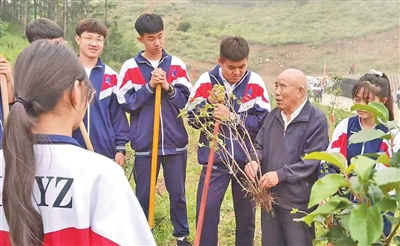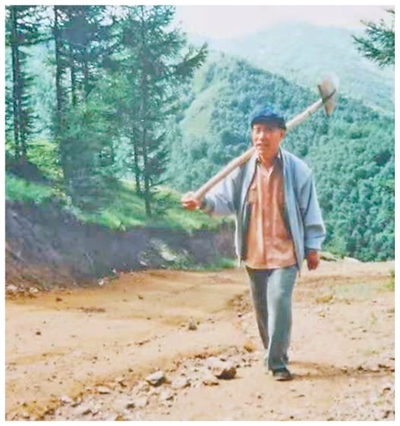




- BRNN
- BRI News
- BRNN News
- Database
Official Documents Polices and Regulations
Inter-government Documents International Cooperation BRI Countries
Business Guide Economic Data BRI Data
Trade
Investment Projects Latest projects
Cases - Content Pool
"With the support of the people, we can create ecological miracles," said Dong Hongru, seated in front of a wooden cabin at Sumu Mountain forest farm in Xinghe county, north China's Inner Mongolia Autonomous Region.
At 86, Dong's eyes still gleam with passion as he gazes at the verdant larch forest — the result of decades of dedication to building and protecting the forest farm.

Dong Hongru (second from right) introduces a tree species to students in Xinghe county, north China's Inner Mongolia Autonomous Region. (Photo courtesy of the interviewee)
Stretching across southern Xinghe county at the junction of Shanxi Province, Hebei Province and Inner Mongolia, Sumu Mountain serves as a vital ecological barrier for the upper reaches of the Yongding River. In the 1950s, aside from a few scattered birch groves, the area was mostly desolate ridges. To protect the remaining birch forest, the county established a ranger station, but harsh conditions soon drove away three successive rangers, leaving behind only an empty mud-brick hut.
In 1958, 19-year-old Dong arrived to take over the post. Braving Sumu Mountain's bitter winter winds, he set out each day with dry rations, spending three to four months traversing every slope. Over time, he became intimately familiar with the mountain's terrain, soil and vegetation. The longer he patrolled, the clearer it became that protection alone was not enough: the mountain needed a forest farm and large-scale tree planting.
Dong drafted a detailed proposal for establishing a forest farm and submitted it to Xinghe county's forestry bureau. His suggestion quickly drew attention, and in 1960, the establishment of the Sumu Mountain state-owned forest farm was officially approved.
When the forest farm was founded, it had only two staff members: Director Zhao Shouli and Dong. Early efforts proved discouraging. They hired several workers and planted 300 to 400 mu (about 20 to 27 hectares) of poplars the first year, but all withered by the following autumn. In the third year, they tried growing mountain peach, apricot, and elm trees, yet none survived in the barren soil.
Refusing to give up, Dong and Zhao appealed to the county's forestry bureau for an additional three years of experimental planting and sought technical support from the forestry bureau of Ulanqab League. An official there suggested visiting forest farms in Hebei and Shanxi provinces, which have terrain and climate similar to that of Sumu Mountain.
In May 1964, the two men trekked to a forest farm in Hebei, carrying provisions on their backs. The sight of larch trees covering the slopes filled them with hope. Director Wang Zhengbao of the forest farm in Hebei welcomed them warmly, guiding them through the mountains to study seedling cultivation and afforestation techniques. Before they departed, Wang gave them 40 kilograms of larch seeds.

Photo shows young Dong Hongru on his way to plant trees in Xinghe county, north China's Inner Mongolia Autonomous Region. (Photo courtesy of the interviewee)
Back at Sumu Mountain, they formed a "seedling cultivation task force" and planted 30 mu of nursery beds before the first snowfall that October. With careful tending, the larch thrived. Each mu yielded about 100,000 saplings with a survival rate exceeding 90 percent.
When Dong became director of the forest farm in 1979, most of the areas suitable for afforestation had already been covered with trees. The farm then entered a new phase that combined forest protection with diversified operations, with Dong strengthening protection measures and enforcing a strict patrol system.
From the day he first arrived at the ranger station in 1958 until his retirement in 1999, Dong devoted more than 40 years to Sumu Mountain, repeatedly turning down opportunities to transfer elsewhere.
Even in retirement, his commitment has not wavered. Dong leased nearby forestland, experimented with new seedling cultivation techniques and grew large numbers of saplings. He also joined a local publicity group, visiting schools, communities and scenic spots to share stories of Sumu Mountain's reforestation and the region's revolutionary heritage.
Today, Sumu Mountain boasts a forest coverage rate of 78.8 percent, a living testament to decades of perseverance.
"I will keep going and continue being a Yugong," Dong said, invoking the ancient Chinese fable of an old man who determinedly tried to move mountains blocking the path in front of his home and eventually managed to move the mountains with perseverance.

Tel:86-10-65363107, 86-10-65368220, 86-10-65363106